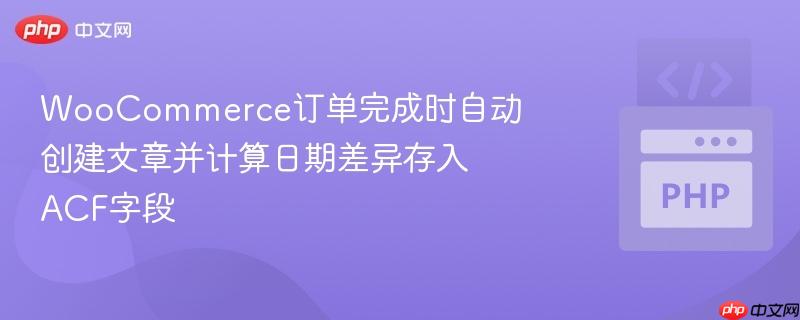
本文将指导开发者如何在WooCommerce订单完成时,自动创建一个自定义文章类型(Custom Post Type),并在此过程中计算订单创建日期与当前日期之间的天数差异。计算出的天数将作为额外数据,存储到Advanced Custom Fields (ACF) 的数字字段中,从而实现订单数据与文章内容的深度集成与自动化管理。
在WooCommerce店铺运营中,有时需要将订单信息转换为独立的文章实体,以便于后续的业务流程处理或数据分析。例如,当一个订单完成时,系统自动生成一篇“成长过程”类型的文章,其中包含订单的详细信息。更进一步的需求是,需要计算从订单创建(即文章发布)至今的天数,并将这个动态计算的值存储在一个ACF数字字段中,以提供实时的时间差数据。
本教程将通过一个WordPress钩子 woocommerce_thankyou 来触发订单完成后的自定义逻辑。主要步骤包括:
我们将整合并优化现有代码,以实现上述功能。
首先,我们需要在 woocommerce_thankyou 钩子中获取订单ID,并从中提取必要的订单和商品信息。然后,使用这些信息创建一个新的自定义文章。
function create_post_after_order_and_calculate_date_diff( $order_id ) {
// 确保 $order_id 是有效的,并且获取订单对象
if ( ! $order_id || ! ( $order = wc_get_order( $order_id ) ) ) {
return;
}
// 获取订单商品信息
$product_ids = [];
$product_names = [];
$product_quantities = [];
$ordeline_subtotals = [];
$product_prices = [];
foreach ( $order->get_items() as $item_id => $item_data ) {
$product_ids[] = $item_data->get_product_id();
$product_names[] = $item_data->get_name();
$product_quantities[] = $item_data->get_quantity();
$ordeline_subtotals[] = $item_data->get_subtotal();
$product_details = $item_data->get_product();
$product_prices[] = $product_details ? $product_details->get_price() : 0; // 确保产品存在
}
// 使用订单的创建日期作为文章的发布日期
$order_creation_date = $order->get_date_created()->format('Y-m-d H:i:s');
// 创建新文章的数组
$new_post_args = array(
'post_title' => "订单 {$order_id}",
'post_date' => $order_creation_date, // 使用订单创建日期
'post_author' => 1, // 可以指定一个管理员用户ID,或根据需求获取当前用户ID
'post_type' => 'groeiproces', // 替换为你的自定义文章类型
'post_status' => 'publish',
);
// 插入文章并获取文章ID
$post_id = wp_insert_post( $new_post_args );
// 检查文章是否成功创建
if ( is_wp_error( $post_id ) || $post_id === 0 ) {
error_log( 'Failed to create post for order ' . $order_id . ': ' . $post_id->get_error_message() );
return;
}
// 后续的ACF字段更新操作需要依赖 $post_id
// ...
}
add_action( 'woocommerce_thankyou', 'create_post_after_order_and_calculate_date_diff', 10, 1 );代码说明:
接下来,我们将订单商品详情保存到预设的ACF中继器字段中。
// ... (接上面的代码)
// 定义ACF字段键
$orderdetails_key = 'field_61645b866cbd6'; // 你的中继器字段键
$product_id_key = 'field_6166a67234fa3';
$product_name_key = 'field_61645b916cbd7';
$product_price_key = 'field_6166a68134fa4';
$product_quantity_key = 'field_6165bd2101987';
$ordeline_subtotal_key = 'field_6166a68934fa5';
$orderdetails_value = [];
foreach ($product_ids as $index => $product_id) {
$orderdetails_value[] = array(
$product_id_key => $product_id,
$product_name_key => $product_names[$index],
$product_price_key => $product_prices[$index],
$product_quantity_key => $product_quantities[$index],
$ordeline_subtotal_key => $ordeline_subtotals[$index],
);
}
// 更新ACF中继器字段
update_field( $orderdetails_key, $orderdetails_value, $post_id );
// ... (继续下面的代码)代码说明:
这是本教程的核心部分。我们将计算订单创建日期与当前日期之间的天数,并将其保存到另一个ACF数字字段。
// ... (接上面的代码)
// 获取订单创建日期对象
// $order->get_date_created() 返回一个 WC_DateTime 对象,可以直接用于 DateTime 构造函数
$order_date_obj = new DateTime( $order->get_date_created()->format('Y-m-d') );
// 获取当前日期对象(只考虑日期部分)
$today_obj = new DateTime( date( 'Y-m-d' ) );
// 计算日期差异
$date_diff = $order_date_obj->diff( $today_obj );
// 获取天数差异
$days_difference = $date_diff->days;
// 定义ACF日期差异字段键
$date_diff_acf_key = 'field_619e20f8a9763'; // 替换为你的ACF数字字段键
// 将天数差异保存到ACF数字字段
update_field( $date_diff_acf_key, $days_difference, $post_id );
} // 函数结束
add_action( 'woocommerce_thankyou', 'create_post_after_order_and_calculate_date_diff', 10, 1 );代码说明:
将上述所有代码片段整合后,完整的解决方案如下:
/**
* WooCommerce订单完成时自动创建自定义文章,
* 并计算订单日期与当前日期之间的天数差异,保存到ACF字段。
*/
function create_post_after_order_and_calculate_date_diff( $order_id ) {
// 确保 $order_id 是有效的,并且获取订单对象
if ( ! $order_id || ! ( $order = wc_get_order( $order_id ) ) ) {
return;
}
// 获取订单商品信息
$product_ids = [];
$product_names = [];
$product_quantities = [];
$ordeline_subtotals = [];
$product_prices = [];
foreach ( $order->get_items() as $item_id => $item_data ) {
$product_ids[] = $item_data->get_product_id();
$product_names[] = $item_data->get_name();
$product_quantities[] = $item_data->get_quantity();
$ordeline_subtotals[] = $item_data->get_subtotal();
$product_details = $item_data->get_product();
$product_prices[] = $product_details ? $product_details->get_price() : 0; // 确保产品存在
}
// 使用订单的创建日期作为文章的发布日期
$order_creation_date = $order->get_date_created()->format('Y-m-d H:i:s');
// 创建新文章的数组
$new_post_args = array(
'post_title' => "订单 {$order_id}",
'post_date' => $order_creation_date, // 使用订单创建日期
'post_author' => 1, // 可以指定一个管理员用户ID,或根据需求获取当前用户ID
'post_type' => 'groeiproces', // 替换为你的自定义文章类型 slug
'post_status' => 'publish',
);
// 插入文章并获取文章ID
$post_id = wp_insert_post( $new_post_args );
// 检查文章是否成功创建
if ( is_wp_error( $post_id ) || $post_id === 0 ) {
error_log( 'Failed to create post for order ' . $order_id . ': ' . $post_id->get_error_message() );
return;
}
// --- 保存订单数据到ACF中继器字段 ---
$orderdetails_key = 'field_61645b866cbd6'; // 你的中继器字段键
$product_id_key = 'field_6166a67234fa3';
$product_name_key = 'field_61645b916cbd7';
$product_price_key = 'field_6166a68134fa4';
$product_quantity_key = 'field_6165bd2101987';
$ordeline_subtotal_key = 'field_6166a68934fa5';
$orderdetails_value = [];
foreach ($product_ids as $index => $product_id) {
$orderdetails_value[] = array(
$product_id_key => $product_id,
$product_name_key => $product_names[$index],
$product_price_key => $product_prices[$index],
$product_quantity_key => $product_quantities[$index],
$ordeline_subtotal_key => $ordeline_subtotals[$index],
);
}
update_field( $orderdetails_key, $orderdetails_value, $post_id );
// --- 计算日期差异并保存到ACF字段 ---
// 获取订单创建日期对象(只考虑日期部分)
$order_date_obj = new DateTime( $order->get_date_created()->format('Y-m-d') );
// 获取当前日期对象(只考虑日期部分)
$today_obj = new DateTime( date( 'Y-m-d' ) );
// 计算日期差异
$date_diff = $order_date_obj->diff( $today_obj );
// 获取天数差异
$days_difference = $date_diff->days;
// 定义ACF日期差异字段键
$date_diff_acf_key = 'field_619e20f8a9763'; // 替换为你的ACF数字字段键
// 将天数差异保存到ACF数字字段
update_field( $date_diff_acf_key, $days_difference, $post_id );
}
add_action( 'woocommerce_thankyou', 'create_post_after_order_and_calculate_date_diff', 10, 1 );
通过上述教程,您已经学会了如何在WooCommerce订单完成时,自动化创建自定义文章,并动态计算订单创建日期与当前日期之间的天数差异,最终将这些信息存储到ACF字段中。这种方法极大地提升了数据管理的自动化水平和灵活性,为进一步的数据分析或业务流程集成奠定了基础。通过灵活运用WordPress钩子和ACF功能,您可以根据具体业务需求,构建出更加强大和智能的WooCommerce解决方案。
以上就是WooCommerce订单完成时自动创建文章并计算日期差异存入ACF字段的详细内容,更多请关注php中文网其它相关文章!

每个人都需要一台速度更快、更稳定的 PC。随着时间的推移,垃圾文件、旧注册表数据和不必要的后台进程会占用资源并降低性能。幸运的是,许多工具可以让 Windows 保持平稳运行。

Copyright 2014-2025 https://www.php.cn/ All Rights Reserved | php.cn | 湘ICP备2023035733号